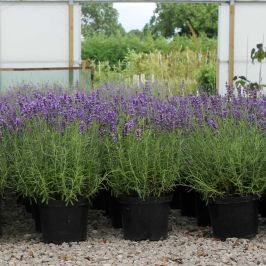Lavandula - An edible hedge
Since medieval times Lavenders have been used in the kitchen, making Lavender hedging an edible option; the flowers can be used either fresh or dried and are traditional used in the sugar or milk of baked goods. Using the same method as you would to create vanilla sugar, place some flower spikes into a jar of sugar and seal. A week later your sugar will be finely flavoured with the sweet perfume of Lavender plants.
Another popular use for your Lavender hedging is to flavour custard or make syrup. So whether it’s a fruity custard tart, shortbread or to flavour iced tea, Lavenders make a great edible hedging option.
Lavender hedging and wildlife
Between June and July, Lavender plants are buzzing with honey bees and bumble bees, as they provide a good source of nectar and pollen. Honey made from Lavender hedging is one of the most highly regarded amongst bee keepers, as the aromatic flowers create a distinctive and delectably flavoured honey.
The flowers of Lavender hedging, if left on, will produce seed heads that make a tasty treat for garden birds, but did you know that some of our garden birds are embracing aromatherapy? Scientists have discovered that Blue Tits will line their nests with medicinal plants such as Lavenders and mint, which have anti-bacterial properties keeping the nursery sterile for its little chick inhabitants.
Lavender hedging in history
The history of Lavenders dates back to the Egyptians, its first documented use was in the mummification process.
The Romans used Lavender oil for bathing and it is referenced regularly in the Bible, however it was then known as 'spikenard' from the Greek name for Lavender plants 'naardus'.
In medieval Europe the washing women were called Lavenders. They used Lavender to scent drawers and laid clothes out to dry on Lavender plants, Lavender is still a well-used surname today.
It is documented that a German Nun, Hildegard of Bingen who lived from 1098-1178, used Lavender water for treating migraines. This decoction was made from vodka, gin or brandy mixed with lavender - though we’re not convinced that it wasn’t the strong spirit curing the headaches!








